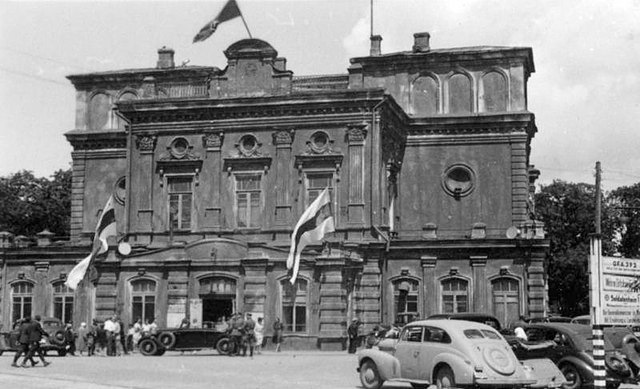Belarusian nationalism refers to the belief that Belarusians should constitute an independent nation. Belarusian nationalism began emerging in the mid-19th century, during the January Uprising against the Russian Empire. Belarus first declared independence in 1917 as the Belarusian Democratic Republic, but was subsequently invaded and annexed by the Russian Soviet Federative Socialist Republic in 1918, becoming part of the Soviet Union. Belarusian nationalists both collaborated with and fought against Nazi Germany during World War II, and protested for the independence of Belarus during the late 1980s and early 1990s.
Konstanty Kalinowski (Belarusian: Кастусь Каліноўскі, romanized: Kastuś Kalinoŭski), one of the leaders of the ill-fated January Uprising, was an early Belarusian nationalist leader
Branislaw Tarashkyevich, a supporter of Protestant religious nationalism and socialism
Fabijan Akinčyc [be], leader of the Belarusian National Socialist Party [be]
Headquarters of the Belarusian Central Council, a puppet administrative body in German-occupied Belarus, with the white-red-white flags in Minsk in 1943.
The January Uprising was an insurrection principally in Russia's Kingdom of Poland that was aimed at putting an end to Russian occupation of part of Poland and regaining independence. It began on 22 January 1863 and continued until the last insurgents were captured by the Russian forces in 1864.
Poland - The Year 1863, by Jan Matejko, 1864, oil on canvas, 156 × 232 cm, National Museum, Kraków. Pictured is the aftermath of the failed January 1863 Uprising. Captives await transportation to Siberia. Russian officers and soldiers supervise a blacksmith placing shackles on a woman (Polonia). The blonde girl next to her represents Lithuania.
Russian army in Warsaw during martial law 1861
"The Battle" from the cycle of paintings "Polonia" dedicated to January Uprising of 1863 – Artur Grottger.
Battles of January Uprising in Congress Poland 1863–1864



![Fabijan Akinčyc [be], leader of the Belarusian National Socialist Party [be]](https://upload.wikimedia.org/wikipedia/commons/thumb/3/3e/Fabijan_Akin%C4%8Dyc._%D0%A4%D0%B0%D0%B1%D1%96%D1%8F%D0%BD_%D0%90%D0%BA%D1%96%D0%BD%D1%87%D1%8B%D1%86_%281907%29.jpg/441px-Fabijan_Akin%C4%8Dyc._%D0%A4%D0%B0%D0%B1%D1%96%D1%8F%D0%BD_%D0%90%D0%BA%D1%96%D0%BD%D1%87%D1%8B%D1%86_%281907%29.jpg)




